
In the Valley of the Kings...
June 29, 1998
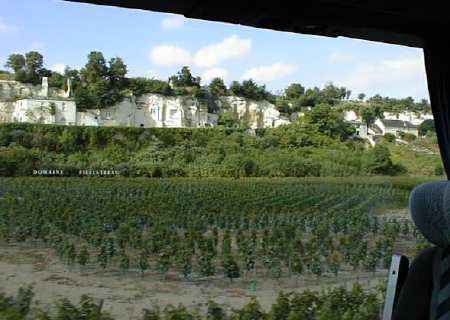
West Virginia University
in Vendée, France

In the Valley of the Kings...
June 29, 1998

Leaving Les Sables early this morning, the WVU-V-mobile first makes a stop at the train station in La Roche-sur-Yon to pick a few of our students who had spent the week-end in Barcelona, Spain. Needless to say, these scholars -- and a few others who had had a busy Saturday and Sunday -- were somewhat spent from such a long trip. This situation was perhaps a presage for a few incidents, minor for the most part, that would prevent this two-day outing from a completely perfect excursion.
We were nevertherless off to visit some of the most hallowed monuments in
France -- the abbeys and castles of the Loire Valley -- and even a few minor glitches
would not be able to ruin this wonderful adventure. Above we see some of the
vinyards that produce the famous wines of this region. In the hillside we also see
the famous "tuffeau", a white limestone that was used in building many of the
astonishing structures of the Loire valley. A close look reveals that the hillside
is riddled with cavities known as the homes of the "Troglodytes"
(cavemen). Actually, they are not homes to primitive cavemen, but storage areas and
even modern housing carved into the limestone. This stone has an amazing ability to
maintain constant temperatures and is excellent for storing fine wines and other
temperature-sensitive items.
Our first official visit was to the Royal Abbey of Fontevraud. This is
where we met our first obstacle. Being the burial place of the Plantagenêt
kings of England, this place is visited by as many of our British co-lingualists as
Frenchmen -- and this despite the fact that at the time of the Plantagenêts, the kings of
England spoke mainly French. The result of all this being that our kind hosts at the
Royal Abbey had prepared for us a visit of the site in English. Upon querying the
the WVU-Vendéens -- who unanimously wanted a visit conducted in French -- Dr. V.
Lastinger and I communicated our desire to visit this site in the language of Richard the
Lion-Hearted (that is French!). This little battle of languages tainted
somewhat our visit, but even more disappointing was the general tone and attitude of the
French guide who was apparently called against his will to lead us. We we
nevertheless able to appreciate the spiritual, economic, and political importance of what
was once among the greatest monasteries and convents of the world. Among the
particularities of this abbey is not only the co-existence of men and women in a religious
order this type, but also the fact that here the highest authority was not an abbot, but
an abbess -- and generally an abbess from the noblest and most powerful families of France
and England.
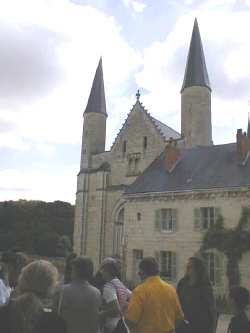
Surely, however, the greatest woman who ever tread the grounds of Fontevraud is
the great Queen Eleonore of Aquitaine (Aliénor d'Aquitaine). Born in 1122 in the
small Vendée village of Nieul-sur-l'Autize, Aliénor would marry king Louis VII of France
in 1137. Her contemporary and sometimes political rival the Abbot Suger is the man
we mentioned during our visit to Saint Denis as the "founder" of gothic
architecture. Though not always in accord with Suger in political matters, Aliénor
did share with him a great love for the arts, and her influence was surely no less than
his in questions of the grand creative impulses of her age. Throughout her life in
every court where she resided she would be accompanied by a cohort of artists, singers,
painters, and weavers whose work is still admired by all who enter into its contact.
Unhappy with Aliénor's independant character and her failure to bear him a male heir,
Louis VII would, despite Suger's strong objection, repudiate her in 1152. This
struck a blow to Suger's plans of strengthening the French monarchy, since Aliénor would
take with her her lands that covered the greatest part of today's southwestern
France. Her marriage to Henry Plantagenêt, who would soon take the English throne
as Henry II of England, was nothing less than a disaster for the ambitions of the French.
(It would take centuries and finally the aid of Joan of Arc for the French throne to bring
this territory definitively back under its power, which finally happened in 1453).
Having spent the last years of her life at Fontevraud, where Henry II, also
frustrated with her independant mind, kept her under the eye of the Fontevrist nuns,
Eleonore died here in 1204. Below we see, clockwise from top left, the tombs of
Aliénor, her husband Henry II de Plantagenêt, their son Richard the Lion-Hearted, and
their daughter-in-law Isabelle d'Angoulème (wife of Aliénor's other son, King John,
signer of the Magna Carta).
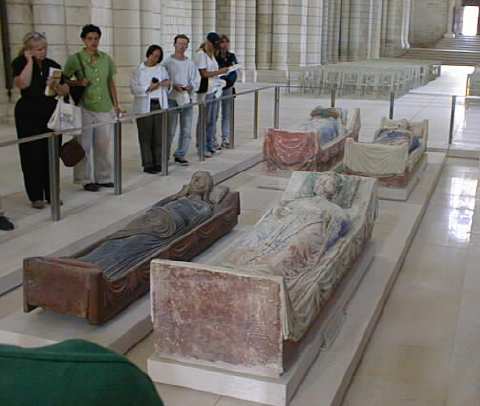
The polychrome "gisant" below represents Aliénor with a book in hand,
symbol both of her piety and of her great learning.
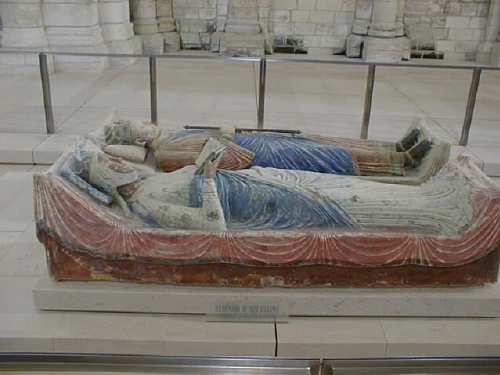
After a pleasant pause for lunch, the Vendéens visit the magnificent castle of Azay-le-Rideau. Originally this sight was that of medieval military castle. One notable story from that time is that of Charles VII (whom Joan of Arc would lead to the throne), who passed here in 1418. At a low point in his fight to reclaim the lands and throne of France from the English, Charles VI was mocked by the soldiers in the fort as he passed by with his apparently enfeabled forces. Charles reacted immediately, taking the castle, and sparing the life of not one of the 350 soldiers posted there. Charles also took the time to burn the surrounding village, whose inhabitants were obviously English sympathizers, to the ground. For centuries, Azay-le-Rideau, would also beknown as Azay-le-Brûlé (the burned).
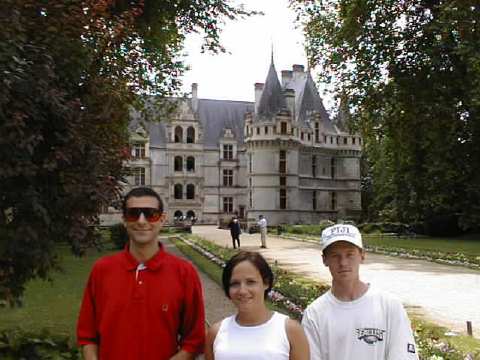
The current structure was builty on the ashes left by Charles VII and dates from the early 1500's, a time when a period of internal peace lead many French nobles to convert their safeplaces away from their military function to become sites of pleasure and ease. A century after Charles VII had razed the medieval fortress, the wealthy financier Gilles Berthelot receives the royal grants of permissions to begin work on very different kind of castle. Thus the year 1518 marks the date when Azay would literally rise from the ashes...
It was in fact for the great king François I that Berhelot worked as financier and tax agent. Below we see Tracy Ting, Amanda Walker, and Kate Wright as they look out from the staircase above them Salamander (emblem of François I) and the Ermine (emblem of François's wife, Claude de France).
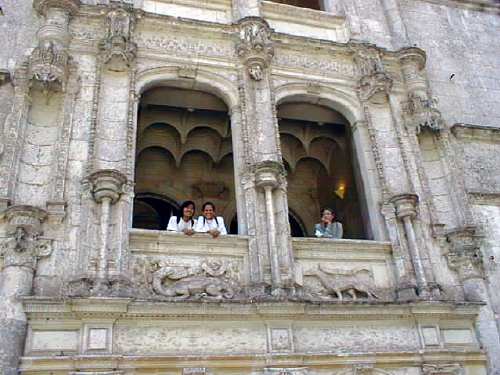
The interior of Azay is decorated with a truly astinishing array of tapistries,
paintings, sculptures, and intricately decorated furniture. Below, we glimpse the
tissued red wall covering around a very early reproduction of François Clouet's
"Lady at her Bath". Once thought to be an original Clouet, the painting is
a portrait of the legendary beauty, Diane de Poitiers, whose own castle we will visit
tomorrow. Diane was the mistress of king great Renaissance king Henri II of France,
the son of François I and not to be confused with the English king Henry II de
Plantagenêt, who lived some 400 years earlier. Diane's days of glory were long, but
numbered despite her apparently limitless influence on the king. When Henri II met
an early death resulting from the wounds of a broken lance that pierced his head in a
friendly jousting match in 1559, the consequences were great for all the court, and
especially for Diane. Henri's wife would take over as regent for her son François
II and she would use her power to force Diane into relative exile. François
himself, who had been wed to Mary Stewart ("Mary Queen of Scotts") in the hopes
of building an alliance against the ever present English threat, would "reign"
only a few months before dying and leaving France in an abominable civil war the set
Catholic against Protestant and brother against brother. Mary Stewart would then
return to her native Scotland only to become the prisoner of Elizabeth I. Mary's
head would not be long on her shoulders.
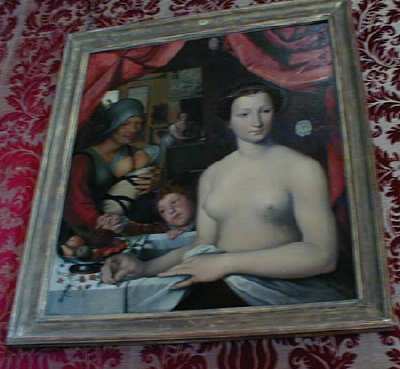
Our WVU-Vendéens are quick to appreciate the beautiful gardens, moats, fountains, and lawns that were designed for the enjoyment of the Renaissance inhabitants of Azay-le-Rideau. After a relaxing afternoon on these luxuriant grounds, we will be off for quick visit of the old city of Tours, before dinner and a night's rest in the nearby hotel.
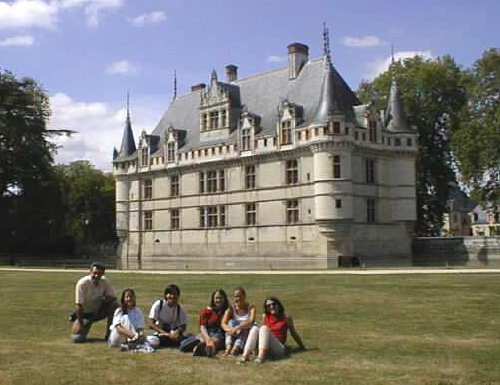
Stay tuned to WVU-V!
Go on to June 30, 1998.